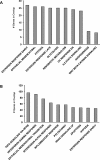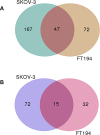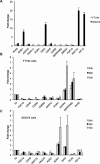Candidate genes and pathways downstream of PAX8 involved in ovarian high-grade serous carcinoma
- PMID: 27259239
- PMCID: PMC5173106
- DOI: 10.18632/oncotarget.9740
Candidate genes and pathways downstream of PAX8 involved in ovarian high-grade serous carcinoma
Abstract
Understanding the biology and molecular pathogenesis of ovarian epithelial cancer (EOC) is key to developing improved diagnostic and prognostic indicators and effective therapies. Although research has traditionally focused on the hypothesis that high-grade serous carcinoma (HGSC) arises from the ovarian surface epithelium (OSE), recent studies suggest that additional sites of origin exist and a substantial proportion of cases may arise from precursor lesions located in the Fallopian tubal epithelium (FTE). In FTE cells, the transcription factor PAX8 is a marker of the secretory cell lineage and its expression is retained in 96% of EOC. We have recently reported that PAX8 is involved in the tumorigenic phenotype of ovarian cancer cells. In this study, to uncover genes and pathways downstream of PAX8 involved in ovarian carcinoma we have determined the molecular profiles of ovarian cancer cells and in parallel of Fallopian tube epithelial cells by means of a silencing approach followed by an RNA-seq analysis. Interestingly, we highlighted the involvement of pathways like WNT signaling, epithelial-mesenchymal transition, p53 and apoptosis. We believe that our analysis has led to the identification of candidate genes and pathways regulated by PAX8 that could be additional targets for the therapy of ovarian carcinoma.
Keywords: PAX8; RNA-seq; fallopian tube secretory epithelial cells; ovarian cancer; transcriptional networks.
Conflict of interest statement
The authors declare that they have no known conflicts of interest in this work.
Figures






Similar articles
-
[Significance and expression of PAX8, PAX2, p53 and RAS in ovary and fallopian tubes to origin of ovarian high grade serous carcinoma].Zhonghua Fu Chan Ke Za Zhi. 2017 Oct 25;52(10):687-696. doi: 10.3760/cma.j.issn.0529-567X.2017.10.008. Zhonghua Fu Chan Ke Za Zhi. 2017. PMID: 29060967 Chinese.
-
Loss of PAX8 in high-grade serous ovarian cancer reduces cell survival despite unique modes of action in the fallopian tube and ovarian surface epithelium.Oncotarget. 2016 May 31;7(22):32785-95. doi: 10.18632/oncotarget.9051. Oncotarget. 2016. PMID: 27129161 Free PMC article.
-
[Origin of ovarian epithelial inclusions and its relationship with the development of low-grade serous carcinoma].Zhonghua Fu Chan Ke Za Zhi. 2011 Oct;46(10):729-35. Zhonghua Fu Chan Ke Za Zhi. 2011. PMID: 22321344 Chinese.
-
The fallopian tube as the origin of high grade serous ovarian cancer: review of a paradigm shift.J Obstet Gynaecol Can. 2014 Feb;36(2):133-140. doi: 10.1016/S1701-2163(15)30659-9. J Obstet Gynaecol Can. 2014. PMID: 24518912 Review.
-
PAX8, an Emerging Player in Ovarian Cancer.Adv Exp Med Biol. 2021;1330:95-112. doi: 10.1007/978-3-030-73359-9_6. Adv Exp Med Biol. 2021. PMID: 34339032 Review.
Cited by
-
CDH6-activated αIIbβ3 crosstalks with α2β1 to trigger cellular adhesion and invasion in metastatic ovarian and renal cancers.Mol Oncol. 2021 Jul;15(7):1849-1865. doi: 10.1002/1878-0261.12947. Epub 2021 May 2. Mol Oncol. 2021. PMID: 33715292 Free PMC article.
-
Robust Score Tests With Missing Data in Genomics Studies.J Am Stat Assoc. 2019;114(528):1778-1786. doi: 10.1080/01621459.2018.1514304. Epub 2019 Feb 26. J Am Stat Assoc. 2019. PMID: 31920211 Free PMC article.
-
Transcriptional profiling of retinal astrocytes identifies a specific marker and points to functional specialization.Glia. 2024 Sep;72(9):1604-1628. doi: 10.1002/glia.24571. Epub 2024 May 24. Glia. 2024. PMID: 38785355
-
The Role of Cancer Stem Cells and Mechanical Forces in Ovarian Cancer Metastasis.Cancers (Basel). 2019 Jul 18;11(7):1008. doi: 10.3390/cancers11071008. Cancers (Basel). 2019. PMID: 31323899 Free PMC article. Review.
-
Proteomic analysis reveals a role for PAX8 in peritoneal colonization of high grade serous ovarian cancer that can be targeted with micelle encapsulated thiostrepton.Oncogene. 2019 Aug;38(32):6003-6016. doi: 10.1038/s41388-019-0842-2. Epub 2019 Jul 11. Oncogene. 2019. PMID: 31296958 Free PMC article.
References
-
- Shaw PA, McLaughlin JR, Zweemer RP, Narod SA, Risch H, Verheijen RH, Ryan A, Menko FH, Kenemans P, Jacobs IJ. Histopathologic features of genetically determined ovarian cancer. Int J Gynecol Pathol. 2002;21:407–411. - PubMed
-
- Nik NN, Vang R, Shih Ie M, Kurman RJ. Origin and pathogenesis of pelvic (ovarian, tubal, and primary peritoneal) serous carcinoma. Annu Rev Pathol. 2014;9:27–45. - PubMed
-
- Perets R, Wyant GA, Muto KW, Bijron JG, Poole BB, Chin KT, Chen JY, Ohman AW, Stepule CD, Kwak S, Karst AM, Hirsch MS, Setlur SR, et al. Transformation of the fallopian tube secretory epithelium leads to high-grade serous ovarian cancer in Brca;Tp53;Pten models. Cancer Cell. 2013;24:751–765. - PMC - PubMed
-
- Cheung HW, Cowley GS, Weir BA, Boehm JS, Rusin S, Scott JA, East A, Ali LD, Lizotte PH, Wong TC, Jiang G, Hsiao J, Mermel CH, et al. Systematic investigation of genetic vulnerabilities across cancer cell lines reveals lineage-specific dependencies in ovarian cancer. Proc Natl Acad Sci U S A. 2011;108:12372–12377. - PMC - PubMed
MeSH terms
Substances
LinkOut - more resources
Full Text Sources
Other Literature Sources
Molecular Biology Databases
Research Materials
Miscellaneous

